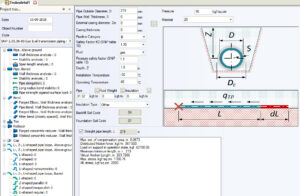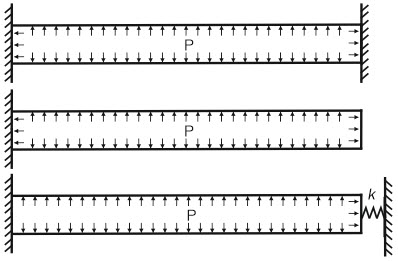Start-Prof is a part of PASS software suite for piping stress analysis, hydraulics analysis, boiler & pressure vessel, heat exchanger, column, tank design & stress analysis is available worldwide since 2018.
Restrained and Unrestrained Zones in the Buried Pipelines
Buried gas and oil pipelines usually are very long and have a small temperature difference. In this case all three types of pipe condition occur: unrestrained, totally restrained and partially restrained.
Let’s assume that soil model is ideal plastic:

In this case the axial stress and axial displacement diagram along the pipeline will be as follows:

As we see unrestrained zone on the right end of the pipe is a very small. The most length of pipeline consists of totally restrained and partially restrained zones.
Anchor load in restrained zone will be:
![]()
Axial force at restrained zone is:
![]()
Stress at restrained zone is:
![]()
Axial force at unrestrained zone is:
![]()
Stress at unrestrained zone is:
![]()
Balance equation:
![]()
Therefore virtual anchor length is
![]()
Stress function in unrestrained zone is:
![]()
Displacement function in unrestrained zone is:

Axial displacement at restrained zone should be zero. Therefore:
![]()
Axial displacement at the right end of the pipe will be
![]()
For more complex and more realistic Elastic-plastic soil model that is used in PASS/Start-Prof pipe stress analysis software the zero displacement (totally restrained) zones is absent:

Let’s assume that restrained zone begins when axial displacement is very small, for example 1% of maximum displacement. Bypassing complex calculations the sliding zone length that is used in PASS/Start-Prof software is:

Virtual anchor length using FEM procedure can be calculated in PASS/Start-Prof Software using Start-Elements module:

Strength Criteria in ASME B31.4 and B31.8 Codes
In real design practice the determination of the restrained zones is very time consuming. For example on the screenshot below the restrained zones of a very long gas pipeline are shown.

That’s why we decided to create universal strength criteria that automatically meets the B31.4 and B31.8 code strength requirements, but can be used for any type of piping. The problem is that ASME B31.4-2016 and B31.8-2016 has unclear requirements for stress analysis.
ASME B31.4 code, paragraph 402.6.2 requires longitudinal stress in unrestrained pipe to be less than 0.75Sy for sustained loads and 0.8Sy for occasional loads.
![]()
This requirement can be extended for all pipe conditions, no matter restrained or unrestrained, but for primary loads. Longitudinal stress in any type of piping from sustained primary loads (weight and pressure) should be less than 0.75Sy:
![]()
M and Fa should be calculated by software including Bourdon effect.
ASME B31.4 code, paragraph 402.6.1 requires longitudinal stress in restrained pipes to be less than 0.9Sy, the equivalent stress should be less than 0.9Sy

This requirement can also be extended for all pipe conditions, but for primary and secondary loads acting simultaneously (weight, pressure, and thermal expansion).

M and Fa should also be calculated by software including Bourdon effect. In this case axial pressure stress will be correct for both restrained and unrestrained zones.
The expansion stress should be checked for both restrained and unrestrained pipes.
The same way ASME B31.8 strength criteria can be improved.
The summary of suggested strength criteria for ASME B31.4 and B31.8 shown in the following tables.




We already implemented the improved ASME B31.4 and B31.8 strength criteria into PASS/Start-Prof software and call it “Start Smart Check”. Every user can select this option and forget about manual selection of restrained and unrestrained pipes in stress analysis software.

Also we added “manual” and “Autodetect” options. Using “manual” option user should select restrained or unrestrained option for each pipe. If “Autodetect” option is selected, Start-Prof automatically use equations for restrained pipe if following condition is truth:
![]()
Manual option is not recommended because it seriously slows down the design process. Autodetect option is not recommended because the strength criteria will be sometimes too conservative and sometimes less conservative for partially restrained pipes.
We recommend users to select “Start Smart Check” option by default because the similar criteria are already used successfully in Start-Prof (GOST codes) for buried pipelines for many years and proved their reliability. You can just draw pipeline and run analysis. There’s no need to divide it into restrained and unrestrained.
Related video about buried piping analysis:
More than 100 Chinese companies choose START-PROF for buried district heating networks analysis with CJJ/T 81-2013 code is used instead of ASME B31.4. CJJ/T 81-2013 is adopted version of GOST 55596-2013 code. This code is free from described above problems, and ideas of ASME B31.4 and B31.8 code improvment in this article was taken from GOST 55596-2013 code.
Example: District heating buried piping network in Universal Studios Park in Beijing calculated using PASS/START-PROF

District heating buried piping network in Universal Studios Park in Beijing

District heating buried piping network in Universal Studios Park in Beijing









Could you please explain whether the prices for the code to analyze the restricted, semi-restricted, and unrestricted buried pipelines:
“Start Smart Check” are available?
Could one buy only the above option? What is the cost for the entire buried pipeline package?
Kind regards,
Dash
please ask your question here: support@passuite.com
or https://passuite.com/support?type=0
Dear thanks for this information but im wondering how to mosel the 130 km i need to model all the vertical bends orr only the change in the horizantal direction of the pipeline.
vertical bends also adds additional flexibility, so yes, need to model it